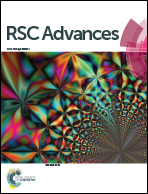Resistive non-volatile memories fabricated with poly(vinylidene fluoride)/poly(thiophene) blend nanosheets†
Abstract
Ferroelectric poly(vinylidene fluoride)/semiconductive polythiophene (P3CPenT) blend monolayers were developed at varying blend ratios using the Langmuir–Blodgett technique. The multilayered blend nanosheets show much improved surface roughness that is more applicable for electronics applications than spin-cast films. Because of the precisely controllable bottom-up construction, semiconductive P3CPenT were well dispersed into the ferroelectric PVDF matrix. Moreover, the ferroelectric matrix contains almost 100% β crystals: a polar crystal phase responsible for the ferroelectricity of PVDF. Both the good dispersion of semiconductive P3CPenT and the outstanding ferroelectricity of the PVDF matrix in the blend nanosheets guaranteed the success of ferroelectric organic non-volatile memories based on ferroelectricity-manipulated resistive switching with a fresh high ON/OFF ratio and long endurance to 30 days.



 Please wait while we load your content...
Please wait while we load your content...